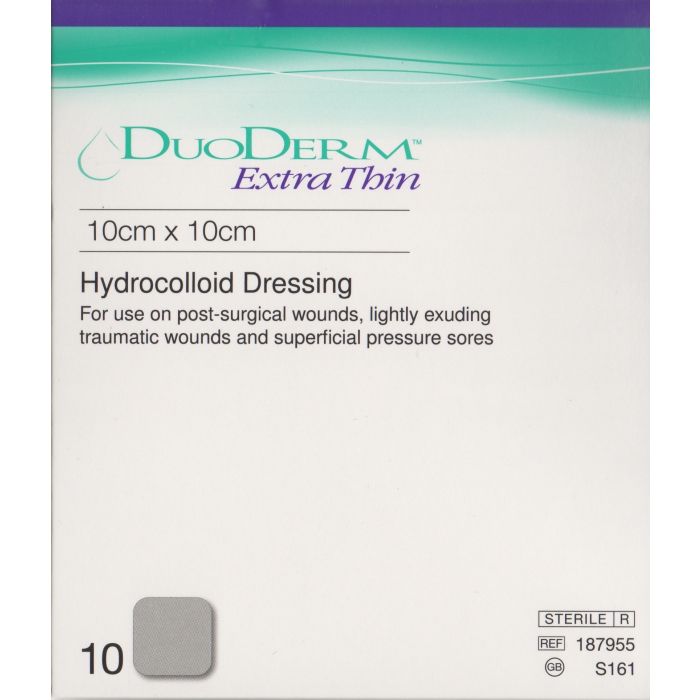What DuoDerm Extra Thin Dressing is ?
DuoDerm Extra Thin, a hydrocolloid dressing, effectively treats post-surgical wounds, minor exuding traumatic wounds, and superficial pressure sores. Its thin design provides gentle yet efficient wound healing, creating an optimal environment for recovery.
What is a Hydrocolloid Dressing and how it works on surgical wounds?
A Hydrocolloid Dressing is a type of wound dressing made of a flexible, water-resistant material that contains gel-forming agents, such as gelatin or pectin. When applied to a wound, the dressing creates a moist environment by interacting with wound exudate (fluid produced by the wound) and forming a gel-like substance. This environment promotes wound healing by maintaining the wound’s natural moisture balance, preventing the wound from drying out and forming a scab.
Hydrocolloid dressings are particularly effective for surgical wounds because they offer several benefits:
- Moist Wound Healing: Surgical wounds heal better in a moist environment. Hydrocolloid dressings provide this environment, which supports cell migration, tissue granulation, and epithelialization (formation of new skin cells).
- Protection: The dressing acts as a barrier against bacteria and other contaminants, reducing the risk of infection.
- Pain Relief: Hydrocolloid dressings can provide some pain relief by cushioning the wound and reducing friction against clothing and other surfaces.
- Autolytic Debridement: The moist environment created by the dressing can aid in the softening and removal of dead tissue (autolytic debridement), promoting a clean wound bed.
- Reduced Scarring: By promoting optimal wound healing conditions, hydrocolloid dressings can potentially lead to reduced scarring compared to dry scab formation.
- Ease of Application: Hydrocolloid dressings are easy to apply and conform well to various wound shapes and body contours.
For surgical wounds, hydrocolloid dressings are typically used on clean, low-to-moderate exuding wounds, where stitches or staples have been removed, and on wounds where primary closure isn’t suitable. They provide a protective and healing environment for the wound, ultimately aiding in faster and smoother recovery. However, it’s essential to follow medical advice and change the dressing as directed by healthcare professionals.
Directions for use
Using a hydrocolloid dressing like DuoDerm Extra Thin on a surgical wound involves a few simple steps to ensure proper application and optimal wound healing:
- Preparation: Before starting, make sure your hands are clean and dry to prevent introducing any contaminants to the wound area.
- Clean the Wound: If instructed by your healthcare provider, gently clean the surgical wound and the surrounding skin using a mild saline solution or as advised. Pat the area dry with a clean, lint-free cloth.
- Select the Right Size: Choose a hydrocolloid dressing size that adequately covers the wound while providing a small border of healthy skin around it. This prevents the dressing from sticking to the wound edges.
- Peel the Backing: Carefully peel the backing from the hydrocolloid dressing. Avoid touching the adhesive surface to prevent contamination.
- Apply the Dressing: Position the sticky side of the dressing directly over the clean and dry wound area. Gently press down the dressing, ensuring it adheres smoothly without wrinkles. Make sure the dressing extends slightly beyond the wound edges to adhere to healthy skin.
- Smooth Out Edges: Smooth out the edges of the dressing to ensure proper adhesion. This helps prevent the dressing from lifting prematurely.
- Change Schedule: The frequency of dressing changes will depend on the amount of wound exudate (fluid) and the specific recommendations from your healthcare provider. Hydrocolloid dressings can often be left in place for several days before changing, as they are designed to maintain their effectiveness even as they absorb wound fluid.
- Monitor Healing: Regularly check the wound and the condition of the dressing during each change. If the dressing becomes saturated, loses its adhesion, or if there are signs of infection (increased redness, swelling, warmth, or unusual discharge), consult your healthcare provider.
- Removal: When it’s time to change the dressing, gently peel it off by starting from one corner and slowly working your way across. Avoid pulling it abruptly, as this could cause discomfort or disrupt the healing process.
- Cleanse the Area: If needed, cleanse the wound area again with a mild saline solution or as directed by your healthcare provider before applying a new dressing.
Remember, always follow the specific instructions given by your healthcare provider. Proper application and monitoring of the hydrocolloid dressing will contribute to effective wound healing and reduced risk of complications. If you have any uncertainties or concerns, consult your healthcare professional for guidance.
This product is typically dispatched within 1-2 working days from date of order
Please note that we do not operate at the weekends. Orders placed after 2pm Friday will not get processed until the following Monday morning.
Standard Delivery
Our standard delivery charge is £2.90.
We use a tracked 48 Hour service for our standard delivery.
Important Information About Shipping to Third-Party Logistics Providers
Please note that Medicine Marketplace cannot be held liable or responsible for any claims of missing or damaged goods that may occur during the shipping to third-party logistics providers, including Amazon’s third-party re-labeller’s.









